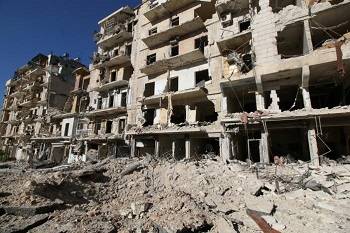When the Russian intervention into the Syrian conflict accelerated in mid-2016, many analysts and partisans declared the "Battle of Aleppo" to hold the key to the future of the Syrian conflict.
Decisive victory one way or another, or the re-establishment of a military stalemate, would dramatically affect the course of the conflict and the possibilities of a political solution, no matter how flawed or unjust.
As 2016 draws to a close, the Russian-led intervention into Aleppo has led to virtually the entire city falling under the control of regime-aligned forces, begging the question: What next?
While sound prediction and analysis in this moment is a challenging, if not entirely flawed, exercise, there are certain trajectories that point to what the future may hold.
There were no restrictions or limitations to the extent of destruction wrought on Aleppo and the approach of full military force is unlikely to change.
The strategy has been validated by sustained territorial gains and the collective indifference of most of the world. Most importantly, however, was the decimation of armed groups' capacity and their increasing inability to resist regime-led advances.
What is emerging then is a new Syrian order, one in which Russian-led forces are able to impose new military and political realities on the conflict.
Opposition groups have thus suffered from both the decreased patronage of their regional sponsors and the serious material degradations caused by the Russian-led intervention.
Groups had consolidated in Aleppo and received displaced fighters from other areas, integrating them into their ranks. This meant that the most significant and potentially powerful concentration of armed oppositionists congealed in Eastern Aleppo, including Ahrar al-Sham, Fateh al-Sham (formerly al-Nusra front), Jaysh al-Mujahideen, and key brigades associated with the Free Syrian Army.
For all intents and purposes, the collapse of the armed opposition in Aleppo has removed the major military threats to regime advancement.
The strategy employed to bring this about was quite clear: bombard and besiege specific areas; cut off supply routes; intensify attacks against any existing infrastructure; and impose ceasefires and related agreements that forced armed groups out of the areas.
Slowly, over the past few months, this strategy has put the death knell to any serious opposition's ability to shape the course of the conflict. Having now been validated by the events in Aleppo, the strategy is sure to be exported to other areas now in the sightline of the Russian-led forces, mainly Eastern Ghouta and the Hama countryside.
While these areas may soon serve as refuges to fighters from Aleppo, these fighters are unlikely to be able to mount any serious military challenge to any further Russian-led advances.
Supply routes from both the southern and northern borders have been effectively cut off and there is virtually no hope for any sort of coordination among armed groups' ranks.
Compounding this reality is the total unwillingness on the part of regime allies to contemplate any political compromise that is not consistent with the regime advances. For example, the UN Security Council attempt to impose a ceasefire on Aleppo was vetoed by Russian and China, while armed groups' calls for a ceasefire and humanitarian corridor were similarly rejected.
What is emerging then is a new Syrian order, one in which Russian-led forces are able to impose new military and political realities on the conflict. Recent events in Homs portend what this may mean for the future.
In that city, as in Hama, a series of car bombs and continued low levels of violence have persisted even in the aftermath of the cities' so-called "liberation". This is merely a repackaging of violence and it is not an insignificant development. It does not mean that violence has gone away or that it is not a threat to Syrians who live in these cities. In just this past month, Homs has seen aid and reconstruction money flow into the city to the point where the United Nations has declared that 99 percent of all war debris is cleared from the city center.
Meanwhile, Russian and regime jets continue to bomb and besiege the countryside around the city.
This is, unfortunately, the kind of future that the Russian intervention is making possible, one in which violence persists amidst the facade of normality and reconstruction. How else could we explain this dichotomy in which Homs gets labelled as free and safe and international organizations rush in to participate in its reconstruction, while a few miles outside of the city violence persists?
The post-Aleppo order is thus unlikely to be defined by the same geography and fragmentation of the country into competing areas of control by different groups. Pockets of control may persist, but it seems unlikely that the contraction of territory will be reversed anytime soon.
With the regime and its allies already unwilling to surrender political concessions, and any sort of external military solution seemingly off the table, we seem to be entering a totally new phase of the conflict in which we need to be serious and pragmatic about what is politically possible moving forward.
In the meantime, as the conflict map changes, so too will the dynamics of violence and human suffering that are unlikely to be alleviated anytime soon.
PHOTO CAPTION
A general view shows the damage at a site hit by airstrikes in the rebel-held besieged al-Qaterji neighborhood of Aleppo, Syria November 23, 2016. REUTERS
Source: Aljazeera.com


 Home
Home Discover Islam
Discover Islam Quran Recitations
Quran Recitations Lectures
Lectures
 Fatwa
Fatwa Articles
Articles Fiqh
Fiqh E-Books
E-Books Boys & Girls
Boys & Girls  Ramadan
Ramadan Fatwa Audios
Fatwa Audios Month of Mercy
Month of Mercy Women
Women Eed Al- Fitr
Eed Al- Fitr Food Recipes
Food Recipes Videos
Videos

 Prayer Times
Prayer Times












